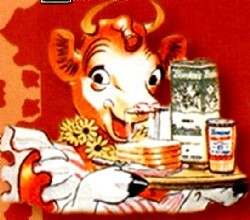“For me,” he confessed, boviscopophobia is an even stronger motive than semi-agoraphobia for staying on the ship when we’re in port. “Boviscopophobia,” he explains in a footnote, is “the morbid fear of being seen as bovine.” He feared looking like a cow.
He imagines that not all the tourists are unaware that, to locals, they might resemble fat cattle. Perhaps, he muses, that despite it, they…
…refuse to let their boviscopophobia rule them:they’ve paid good money to have fun and be pampered and record some foreign experiences, and they’ll be goddamned if they’re going to let some self-indulgent twinge of neurotic projection about how their Americanness appears to malnourished locals detract from the 7NC Luxury Cruise they’ve worked and saved for and decided they deserve.
But Wallace is too truth-loving to compartmentalize. He can’t shake “a self-conscious and somewhat condescending concern about how I appear to others that is (this concern) 100% upscale American,” which is to say:
…large, fleshy, red, loud, coarse, condescending, self-absorbed, spoiled, appearance-conscious, ashamed, despairing, and greedy; the world’s only known species of bovine carnivore.*
His may be the purest example of self-loathing conflated with America-bashing we have. You don’t have to be a self-adoring patriot to see why non-self-loathers and the self-loathing-impaired might not want to ratify this sort of vision, might resent it, even.
Liberals get accused of being self-loathing a lot because, well, we often are. And we get accused of hating America because, hey, many smart, articulate liberals—like many radical Christian evangelicals—genuinely do. That is, they can only love America when they imagine it filled with people who agree with them. And it isn’t.
You can try to explain to activists why the odor of this attitude is like weaponized ammonia when it comes to organizing for change in the US, why most of their country-folk would rather eat glass—or at least corndogs—rather than identify with a vortex of self-awareness, self-rejection and moral superiority that seems destined for suicide, but listening, alas, is not the visionary’s strong suit.
What’s great about the OWS upsurge, however, is that it rightly re-assigns ordinary Americans to the ranks of the oppressed and despised—hence (for anti-authoritarian power-haters) the loveable underdog sector of the world. There’s an opportunity here to offset liberal self-and-other revulsion with some genuine fellow feeling. I hope we grab it. Fan as I am of self-loathing as insightful as David Foster Wallace’s, I don’t want his sensibility leading our country into another impotence-infatuated Naderite ditch.
Fellow citizens: Do not be afraid! Look like a cow! Love yourself as you would any other grass-fed, pasture-raised icon of bucolic simplicity. Stuff your face and your shopping bags. Waddle to freedom. Drop your cow pies and make your milk. Watch your Housewives of Atlanta. Remember: We, too, deserve liberty, good governmnt, democracy, and a reasonable amount of equality—no matter how bovine we appear to great writers…or to ourselves.
*for quotes, see .pp 310-311 hardcover ed.










 wear handcuffs as jewelry?
wear handcuffs as jewelry? artist
artist  The brilliant Website,
The brilliant Website,  Courtney Love
Courtney Love





 The Spitzers appeared to be in an advanced state of self-loathing when Eliot abandoned the gubernatorial ship yesterday. But loathing over what? Was his shame as durable as he claimed in
The Spitzers appeared to be in an advanced state of self-loathing when Eliot abandoned the gubernatorial ship yesterday. But loathing over what? Was his shame as durable as he claimed in  In US cinema, self-loathing in the line of duty was pretty much this year’s theme, making it hard to award SL4B’s coveted SLOscar to just one performance in the category: “Best Depiction of Self-Loathing.”
In US cinema, self-loathing in the line of duty was pretty much this year’s theme, making it hard to award SL4B’s coveted SLOscar to just one performance in the category: “Best Depiction of Self-Loathing.” da Swinton in Michael Clayton both played ambitious strivers who spend their lives desperately running from themselves towards something they wrongly assume will be better. Swinton achieves a shivering state of free fall, and maintains it brilliantly, while Lewis keeps shooting black bile skyward as if we will never run out of the stuff. Bravo.
da Swinton in Michael Clayton both played ambitious strivers who spend their lives desperately running from themselves towards something they wrongly assume will be better. Swinton achieves a shivering state of free fall, and maintains it brilliantly, while Lewis keeps shooting black bile skyward as if we will never run out of the stuff. Bravo. Well I just can’t decide. Isn’t that pathetic? Except I will say that Daniel Day Lewis’s Daniel Plainview does a little bit too much eye-crossing, shouting and turning red in the face to make a credible self-loather. When he famously bellows “I’ve abandoned my boy!” at a revival meeting, you suspect what he’s really feeling is tired of ingratiating himself with the saps he’s fleecing. There’s never a moment in which Lewis’s Plainview sees the worst in himself and figures it’ll be hard to live with. You can imagine him pouring himself a stiff one and cutting himself some slack, like, “Hey: At least I didn’t invade Iraq.” The giants of self-loathing don’t hedge like that. It was a fine performance, but less a portrait of a self-loather than of someone interestingly loathsome.
Well I just can’t decide. Isn’t that pathetic? Except I will say that Daniel Day Lewis’s Daniel Plainview does a little bit too much eye-crossing, shouting and turning red in the face to make a credible self-loather. When he famously bellows “I’ve abandoned my boy!” at a revival meeting, you suspect what he’s really feeling is tired of ingratiating himself with the saps he’s fleecing. There’s never a moment in which Lewis’s Plainview sees the worst in himself and figures it’ll be hard to live with. You can imagine him pouring himself a stiff one and cutting himself some slack, like, “Hey: At least I didn’t invade Iraq.” The giants of self-loathing don’t hedge like that. It was a fine performance, but less a portrait of a self-loather than of someone interestingly loathsome.